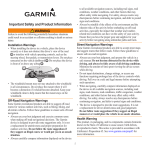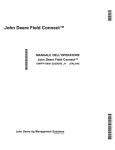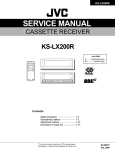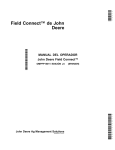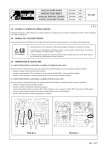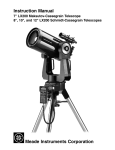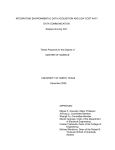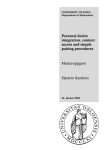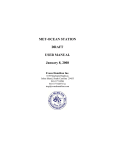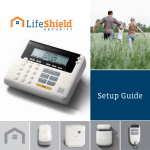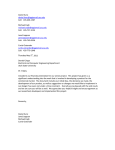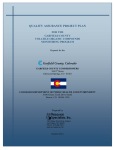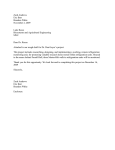Download Final Report Outline - Electrical and Computer Engineering
Transcript
Rocky Mountain Space Grant Observatory Final Report Table of Contents Table of Contents ............................................................................................................................ 1 Abstract ........................................................................................................................................... 4 Group Members .............................................................................................................................. 5 1.0 Introduction .......................................................................................................................... 6 2.0 Problem Statement ............................................................................................................... 6 3.0 Project Organization ............................................................................................................ 6 3.1 Engineering Team ............................................................................................................ 6 3.2 Semester Timeline ............................................................................................................ 6 3.1 Cost Estimation ................................................................................................................ 8 4.0 Weather Subsystem ............................................................................................................ 12 4.1 Sensors ........................................................................................................................... 12 4.1.1 TE525 Rain Gauge .................................................................................................. 12 4.1.2 03101 R.M. Wind Sensor........................................................................................ 12 4.1.3 HMP45C Temperature/Humidity Sensor ............................................................... 13 4.1.4 Sensor Manuals ....................................................................................................... 14 4.1.5 Weather Research ................................................................................................... 14 4.1.6 Sensor Set Up.......................................................................................................... 14 4.1.7 Sensor Power .......................................................................................................... 15 4.2 Software ......................................................................................................................... 15 4.2.1 Weather Program .................................................................................................... 16 4.2.2 Dome Hatch Control ............................................................................................... 24 4.3 GUI (RSView32)............................................................................................................ 25 4.3.1 Creating Tags ............................................................................................................... 25 4.3.2 Data Logging ............................................................................................................... 26 5.0 Dome Operations Subsystem ............................................................................................. 26 5.1 Summary of Design Process .......................................................................................... 26 5.1.1 Design One................................................................................................................... 28 5.1.2 Design Two .................................................................................................................. 29 5.1.3 Summary of Final Results............................................................................................ 29 5.2 Problem Analysis ................................................................................................................ 30 5.2.1 Review of Problem ...................................................................................................... 30 5.2.2 Design Considerations ................................................................................................. 30 5.2.2.1 Limit Switches ...................................................................................................... 31 5.2.2.2 Motor Delays ........................................................................................................ 31 5.2.3 Summary of Specifications .......................................................................................... 32 5.3 Detailed Design, Schematics, and Layout .......................................................................... 32 5.3.1 Motor/Sensor................................................................................................................ 32 5.3.1.1 Motor..................................................................................................................... 32 5.3.1.2 Sensors .................................................................................................................. 35 5.3.2 PLC .............................................................................................................................. 37 5.3.2.1 PLC Hardware ...................................................................................................... 37 5.3.2.2 PLC System Overview .......................................................................................... 38 1 5.3.2.2 PLC Code .............................................................................................................. 39 5.4 Project Implementation/Operation and Assessment ........................................................... 46 5.4.1 Current Implementation ............................................................................................... 46 5.4.2 Finishing Work Process ............................................................................................... 46 5.4.2.1 Power Failure ........................................................................................................ 46 5.4.2.2 Close Shutter/ Weather ......................................................................................... 46 5.4.2.3 Sensors .................................................................................................................. 47 5.4.2.4 Dome Rotation ...................................................................................................... 47 6.0 Telescope Subsystem ......................................................................................................... 45 6.1 Existing Hardare/Conditions .......................................................................................... 45 6.1.1 Telescope Subsystem .............................................................................................. 45 6.1.2 Location/Operating Conditions............................................................................... 47 6.2 Design Constraints ......................................................................................................... 47 6.2.1 Operating Software ................................................................................................. 47 6.2.2 Vibration Control .................................................................................................... 48 6.3 Designs ........................................................................................................................... 48 6.3.1 Software Selection .................................................................................................. 48 6.3.2 Camera Selection .................................................................................................... 49 6.3.3 Vibration Control .................................................................................................... 50 6.3.4 Cable Interfacing..................................................................................................... 50 6.4 Implementation............................................................................................................... 52 6.4.1 Computer Software Configuration .......................................................................... 52 6.4.2 Camera Installation ................................................................................................. 53 6.4.3 Floor Mounting/Vibration Control ......................................................................... 54 6.4.4 Telescope Alignment .............................................................................................. 54 6.4.5 Equatorial Mount .................................................................................................... 55 7.0 Final Scope of Work Statement .............................................................................................. 57 7.1 What Has Been Done .......................................................................................................... 57 7.2 Lessons Learned.................................................................................................................. 58 7.3 Power Installation Issues..................................................................................................... 59 8.0 Maintenance ............................................................................................................................ 60 8.1 Duties .................................................................................................................................. 60 8.2 Dome Instructions ............................................................................................................... 61 9.0 Conclusion .............................................................................................................................. 64 10.0 Special Thanks to Sponsors .................................................................................................. 64 2 List of Figures FIGURE 1: OVERALL SYSTEM ........................................................................................................... 7 FIGURE 2: GANTT CHARTS ............................................................................................................... 8 FIGURE 3: SINE WAVE TO SQUARE WAVE CIRCUIT ....................................................................... 11 FIGURE 4: 5 VOLT VOLTAGE REGULATOR ..................................................................................... 13 FIGURE 5: 12 VOLT VOLTAGE REGULATOR ................................................................................... 13 FIGURE 6: WEATHER PROGRAM LADDER LOGIC ............................................................................ 21 FIGURE 7: PLC VARIABLE/MEMORY LIST ..................................................................................... 22 FIGURE 8: INDUCTION MOTOR ....................................................................................................... 31 FIGURE 9: SOFT STARTER .............................................................................................................. 31 FIGURE 10: VOLTAGE VS. TIME GRAPH ......................................................................................... 32 FIGURE 11: SOFT START WIRE DIAGRAM ...................................................................................... 32 FIGURE 12: HARDWARE SETUP ...................................................................................................... 34 FIGURE 13: SENSOR CIRCUIT ......................................................................................................... 34 FIGURE 14: PLC FRONT ................................................................................................................. 35 FIGURE 15: ERROR CORRECTION ................................................................................................... 36 FIGURE 16: ROUTINE CHECK ......................................................................................................... 37 FIGURE 17: ROTATION CODE ......................................................................................................... 41 FIGURE 18: SHUTTER CODE ........................................................................................................... 43 FIGURE 19: TELESCOPE SYSTEM BLOCK DIAGRAM ....................................................................... 47 FIGURE 20: REMOTE HANDBOX ..................................................................................................... 49 FIGURE 21: ENVISGE IMAGING ....................................................................................................... 49 FIGURE 22: INTERFACE FLOW DIAGRAM ....................................................................................... 51 FIGURE 23: SETTING UP LOCATION SETTINGS ............................................................................... 53 FIGURE 24: COM PORT SETTINGS ................................................................................................... 53 FIGURE 25: SENSOR CIRCUIT FRONT .............................................................................................. 56 FIGURE 26: SENSOR CIRCUIT BACK .............................................................................................. 56 List of Tables TABLE 1: LIST OF MATERIALS ....................................................................................................... 10 TABLE 2: LINKS TO SENSOR MANUALS ......................................................................................... 12 TABLE 3: ROTATION CODE OVERVIEW .......................................................................................... 37 TABLE 4: SHUTTER CODE OVERVIEW ............................................................................................ 42 3 Abstract The goal of the Space Grant Internet Telescope Network (SGITN) is to make astronomical instruments available to people around the world through the internet. This means that students all around the world can access telescopes all around the nation. This network of telescopes will allow students to use expensive equipment without the setup cost. This will also allow students in locations where sky observations are not possible to gain interest in space by a click of their mouse. All telescopes are in permanent locations, and "using them" means sitting down at an internet-connected computer, logging into the instrument, and starting to take pictures. This eliminates literally hours of set-up and tear-down work at the beginning and end of the observing session, and it's actually possible to do other things (like your homework) while taking long exposure images. The Rocky Mountain Space Grant Observatory located at Utah State University is one of six telescopes in the SGITN. The others are located in North Dakota and South Dakota. 4 Current Group Members Systems Lead Scott Farnsworth Weather Matt Pine, Brok Thayn, Monica Berrett Dome Operations Ben Jeppsen, Evan Howard, Nate Erni Telescope Brok Thayn, Matt Pine Former Group Members Systems Lead Josh Williams Dome / Weather Brok Thayn, Scott Farnsworth, Matt Pine, Monica Berrett Controls Ben Jeppsen, David McDougall, Khemmer Porter, Dan Morgan Telescope Quinn Vellinga, Xing Wei, McKay Williams, Mac Fillingim 5 1.0 Introduction Utah State University (USU) is currently working on a web based telescope in conjunction with other universities and organizations around the world. Each university or organization will have their own telescope, making a network of telescopes around the world. These telescopes will display the images they observe on the web in real time. Students will be able to login to the website and reserve the telescope for a predetermined time. The student using the telescope will have the ability to direct the telescope wherever they see fit. Having a network of telescopes allows the user to look into space during the daytime by accessing a telescope in another part of the world, for example a telescope in Europe or Asia. One of the concerns with the USU telescope is how to protect it from the environment if the system is completely operated remotely. The dome needs to be automated and programmed to close when bad weather arises. 2.0 Problem Statement An overview of the project is shown in the figure below. The flow of this report will be broken down by subsystem. The weather subsystem includes sensors and their communication with the PLC (Programmable Logic Controller) along with tracking and logging data. Dome control subsystem consists of the motors, sensors and programs coded in latter logic for the PLC. The telescope subsystem covers the telescope operations, operating and interfacing the camera, the equatorial wedge, and alignment issues. 6 Telescope Subsystem User Internet ACP Program CCD Camera PC USB RS232 Telescope Master Weather Subsystem Wind Dome Subsystem DH+ Sensor Slave Shutter Motor Rain/Snow Sensor PLC Humidity/Temp Rotation Motor Barcode Sensor Scanner Figure 1: Overall System The current Rocky Mountain Space Grant Observatory is completely manually operated. One has to get onto the roof of the Engineering Laboratory EL building and manually flip the switch to open the observatory. This can be very tedious and time consuming. The user has to stay up in the observatory the whole time he or she wants to use the telescope in case bad weather occurs, to shut the dome in order to preserve the telescope. This project will convert the dome into a fully automated system. There are a few constraints that will affect the design. There is an existing dome, two existing dome motors, and three sensors that have to be used in the design. The subsystem has to be able to work in all types of weather situations taking place in Logan, Utah. 7 A team of electrical engineering students from Utah State University have developed the design and some preliminary implementation to achieve the overall goal of a stand-alone, fullyfunctional observatory system. 3.0 Project Organization 3.1 Engineering Team Members of the Observatory team are enrolled and active in a University ElectricalMechanical Engineering course designed to specialize in Space Systems Engineering. As team members provide personal initiative and experience to the group, the project progresses and members benefit from one another. The Dome Operations Sub-group works with dome operations including motors, PLC interface, and power issues. The Weather Sub-group relates to design pertaining to weatherrelated sensors. The Telescope Sub-group deals with aspects of interfacing an automated telescope with computer controlling software. The team works together in designing and testing to plan interfacing and eventual system implementation. 3.2 Semester Timeline Each of the three groups created a timeline to outline key goals and accomplishments through the progression of the semester. An innovative and helpful program was used to organize the layout of the project, available for free, called Gantt Project. 8 Weather Telescope 9 Dome Operations Figure 2: Gantt Charts The initial layout of the project included only preliminary preparations and as the group began to ascertain specific needs for the project, additional tasks were added and specific group organization began to take place. 3.3 Cost Estimation Below is a table which consists of a parts list and the associated cost for the rotation of the dome. This table only includes parts needed and does not include any engineering time spent on the project. 10 Subgroup Item Brand Model Qty Price Total $4.98 $44.97 USB extender Vigor VAD-1120 1 telescope Telescope Meade LX200R 14" 1 telescope Ultra Wedge* Meade 1 telescope CCD camera Meade LX200R 14" Deep Sky Imager PRO II 1 Prior Equipment $0.00 Campbell HMP45C 1 $214.00 $0.00 $214.00 Young Campbell Campbell Campbell Campbell Campbell 03101 R.M. TE525 CS705 N/A N/A CM 204 1 1 1 1 1 1 $216.00 $145.00 $460.00 $420.00 $175.00 $78.00 $0.00 $0.00 $0.00 $0.00 $0.00 $0.00 $216.00 $145.00 $460.00 $420.00 $175.00 $78.00 Campbell CM 220 1 $21.00 $0.00 $21.00 Various N/A 1 $3.50 $0.00 $3.50 Allen Bradley PLC-5/25 1 Allen Bradley RSLogix, View,Linx 1 Schneider 9999SC8 1 $138.95 $0.00 $138.95 Square D QO20 1 $12.00 $5.00 $17.00 Dayton 5ZC11 10 $5.65 $10.00 $156.50 Square D Phoenix Contact L211N 2 $14.00 $0.00 $28.00 (Purchased) 30 $0.34 $0.00 $10.20 weather weather weather weather weather weather weather weather weather dome dome Temp/Humidity Sensor Anemometer Rain Gauge Snowfall Adapter* 6' Tripod Radiation Shield Cross Arm Right Angle Mount Kit Circuit for Anemometer PLC 5/25 with misc. I/O Cards PLC Software $39.99 Prior Equipment $499.95 Shipping telescope dome dome Terminal Blocks dome 24 VAC, 8 Amp Transformer Triad (Donated) 1 dome Barcode Sensor Symbol (Donated) 1 dome dome Pushbutton E-stop Motor Soft Start PLC ASCII Card (RS-232) Square D Telemecanique Altistart 01 1 1 Donated Equipment Donated Equipment $11.00 $99.00 Allen Bradley 1771-DA 2 Indicator Light Square D dome dome dome dome dome 8 Amp and 5 Amp Fuse & Holders THHN Wire as needed (in feet) Limit Switches dome UPS dome dome dome Drive Wheel dome PS/2 to RS232 * - still need to purchase Buss Any Allen Bradley Power Waire True Wheel Awce Square-D 9001 CC/Dule Elmt THHN 14 AWG A02T 5115 1000VA True Wheels Awce #GP-2 $15.00 $514.95 Donated Equipment Donated Equipment Schneider HandOff_Auto 20 Amp QO Breaker Dayton 24 Volt Coil 10 Amp Relay Disconnect Switch dome $0.00 $0.00 $0.00 $0.00 $7.00 $11.00 $106.00 $25.00 $5.00 $60.00 1 $19.99 $0.00 $19.99 2 $5.00 $5.00 $20.00 100 $0.30 $5.00 $530.00 2 $10.00 $5.00 $30.00 1 $300.00 $20.00 $320.00 1 1 $50.00 $50.00 $5.00 $5.00 $55.00 $55.00 Total Cost: $3,850.06 11 Table 1: List of Materials 4.0 Weather Subsystem 4.1 Sensors 4.1.1 TE525 Rain Gauge In order to protect the telescope from precipitation a rain sensor is incorporated into the system. USU already has the TE525 rain gauge sensor so that is being used. The TE525 works as a simple switch. When rain fills up the tipper, it tips and closes a switch. Each tip represents 0.01 inches of rain have fallen. The input to the TE525 will be 5VDC. The output signal will be a 5V pulse wave which will be directly inputted into the PLC’s TTL logic board where it will count the pulses (frequency). The PLC will count the pulses over a predetermined amount of time to determine if it is safe for the dome to open (see Weather Research section). During the winter a snowfall adaptor will be placed on top of the TE525 which will melt the snow to have the TE525 work if it were raining. 4.1.2 03101 R.M. Wind Sensor In order to protect the telescope from debris in the air an anemometer is incorporated into the system. The anemometer that is being used is the 03101 R.M. Wind Sensor. This sensor requires no input voltage to power the sensor; it generates its own AC sine wave. This, however, is a minor problem as the PLC cannot accept a low frequency sine wave input. To convert the sine wave output to a square wave a LM358 operational amplifier and a 2N3904 BJT were used. The operational amplifier is used in an inverting non-linear configuration with a gain of ten. The BJT is connected to the output of the op-amp to generate the 5V pulse wave. The PLC counts 12 the number of pulses per second (frequency) and uses a simple equation to produce the wind speed. The PLC will then close the dome when a predetermined threshold is reached (see Weather Research section). Below is the schematic for the sine wave to square wave circuit. 1 18V IN OUT 3 12V 1u 1 18V 1u 3 5V 1u 1u LM7805 LM7812 pin 2 goes to ground 0 OUT IN 0 0 pin 2 goes to ground 0 5V R2 100k R4 R1 10k R3 3 Vout-square wave LM358 R5 1 2.4k 1V 10k Q1 2N3904 8 10u 1k + 2 Vin-sine wave - C1 4 12V 0 0 R6 12k R7 5V in 1V out 3k 0 Figure 3: Sine Wave to Square Wave Circuit 4.1.3 HMP45C Temperature/Humidity Sensor In order to protect the telescope from severe cold and for early storm detection a temperature and relative humidity sensor is incorporated into the system. The HMP45C Temperature/Relative Humidity sensor is being used for this application. The recommended input voltage to the sensor is 12VDC. To power the sensor the 12V voltage regulator circuit is used (see power section). The output of both the temperature signal and the relative humidity signal ranges from 0.001V to 1V. These output signals are also analog. The PLC has an analog 13 input card that can read voltages from 0 to 5 volts with a precision of 12 bits (4096 values). This leaves 819 values to read the 0.001 to 1 volt (1000 values). This will loose some accuracy of the temperature and relative humidity reading but not a significant amount for the needs of this system. The data loss is somewhere on the order of + 0.2 degree and + 0.2 % humidity. The PLC will read in these values and compute the temperature and relative humidity and, based on predetermined data, will close the dome (see Weather Research section). 4.1.4 Sensor Manuals Below is a table of links to the sensor manuals. These can also be found on the project website http://rmspacegrant.googlepages.com. Sensor TE525 Rain Gauge 03101 R.M. Wind Sensor HMP45C Temp./Hum. Manual www.campbellsci.com/documents/manuals/te525.pdf www.campbellsci.com/documents/manuals/03001.pdf www.campbellsci.com/documents/manuals/hmp45c.pdf Table 2: Links to Sensor Manuals 4.1.5 Weather Research Some weather research has been performed to help determine the thresholds of the weather conditions in order for the dome to close. The dome will be closed if any of the conditions occur: humidity rises above 95%, the rain bucket ever tips, or the wind gets above 40 miles per hour. If any of theses weather conditions occur the dome will close and continue to read the sensors to see when it is okay to open the dome again. 4.1.6 Sensor Set Up All of the sensors were mounted on an anchored tripod on top of the EL building at USU. The sensors were then hooked up to the board with the circuitry found in figure 1 which is 14 connected to a wire to the PLC. The board was then encapsulated in a water tight box to keep it protected from the elements. 4.1.7 Sensor Power To power the sensors a 120VAC to 12VDC transformer was used. The actual output of the transformer was 18VDC. In order to get the desired 12VDC, for the HMP45C Temperature/Humidity Sensor, and 5VDC, for the TE525 Rain Bucket, two simple voltage regulators were used. The LM7805 was used to get the 5VDC and the LM7812 was used to get the 12VDC. Below are the schematics for the voltage regulator circuits. 1 18V IN 3 OUT 5V 1u 1u LM7805 0 pin 2 goes to ground 0 Figure 4: 5 Volt voltage Regulator 1 18V IN OUT 3 12V 1u 1u LM7812 0 pin 2 goes to ground 0 Figure 5: 12 Volt Voltage Regulator The capacitors are used to dampen any voltage spikes. 4.2 Software The PLC uses RSLogix5 software to write the control program for the PLC. RSLogix5 is a Windows based ladder logic programming tool. It visually shows the ladder program as well as contains several other tools to make the programming process simpler. It was a little difficult 15 to use at first because of the lack of available online documentation as well as the documentation that came with the installation. But the program does contain a very well organized help section. From that the program was able to be used. The first difficulty with the program and PLC was getting the modules to work. The analog input module needed to be calibrated. The calibration was done by hand, looking through manuals and the documentation. That did not work. Then it was discovered that the program RSLogix5 will put the correct calibration lines of code into the program. Knowing this before hand would have saved quite a bit of work. Ladder logic is not executed sequentially as is done in C++ and other programming languages. Each “rung” or instruction on the ladder is executed at the same time. The best way to help understand ladder logic is to think of each rung as a logic expression. If the first condition(s) is (are) true then the instruction will be executed. If a rung is empty before an instruction that is considered as a true value and the instruction will always be executed each time the program is swept. 4.2.1 Weather Program The weather program is the first step in accomplishing tracking of the weather conditions around the dome and closing the dome in inclement weather conditions. This program is set up to take the sensor data and interpret that into the corresponding measurement value. Then the GUI / RSView32 program can take those values off of the PLC and log them into metadata on the computer. The next step in the programming process will be incorporating the dome open and close routines which will be discussed later on. 16 There are four weather sensors that are being used temperature, humidity, rain and wind. The specifics on each sensor are found in the sensor section of this report. These four weather sensors are connected to the PLC using the differential analog input module. These four inputs have been set up to give a zero to five volt signal; the analog module has been set up to accept this voltage range. The analog input module is a 12-bit A/D converter as has been mentioned above. Therefore the weather signals are broken down into numbers ranging from 0 – 4095. Zero represents zero input voltage and 4095 represents five volts. That gives a resolution of 819 per volt. The temperature and humidity sensor gives a voltage value depending on the measurement. The rain sensor gives a pulse per 0.01 inches of rain fall. The wind sensor and circuitry will also give a pulse signal, one per revolution. The weather program must take the temperature and humidity data from the analog module and convert that to the actual voltage given by the sensors. Then it can use the conversion equations supplied with the sensors to give the corresponding weather condition reading. But as for the wind and rain sensor the program must compare if the input is over a certain amount to signify that a pulse was sent from the sensor. The program must accumulate the total number of pulses sent in a certain amount of time. Then convert that into the wind speed and precipitation amount. The program is laid out in this fashion. First are the calibration rungs to set up the analog input module. That is followed by procedures to get the current day and hour from the PLC for precipitation time tracking as well as procedures to update that information every hour and day. Next is the rain counter and precipitation amount calculation. The precipitation is set up to record the amount received in the hour as well as in the whole day. The wind timer, counter and calculations come after the rain section. The wind sensor calibration equation is set up to 17 calculate the wind speed by how many revolutions per second it spins. Therefore the wind timer will give the time aspect and the wind counter will count how many revolutions in that time. Then the calculations will give an average revolution per timer time (ten seconds) and that will be used in the calibration equation to give the wind speed. Last and not least are temperature followed by humidity measurement calculations. These are done by converting the A/D value to the voltage value sent by the sensor. Then the program puts that value into the calibration equation to give the measurement value. Below is the weather program as it is laid out in RSLogix5. That is followed by a list of the variables used in the PLC memory/IO and their address location, symbol and description. 18 19 20 21 22 Figure 6: Weather Program Ladder Logic 23 Figure 7: PLC Variable/Memory List 4.2.2 Dome Hatch Control The next step in the dome opening control program is to implement the open and close routines of the dome along with the verification of good weather conditions for dome operation. The first part is to include a bit in the PLC that will be set or reset using the computer to signify 24 that the telescope is in use (set) or not in use (reset). This means to open the dome for operation or close it because it is not needed at the moment. This variable will be called IN_OPER for in operation. The next thing is to implement a routine that will always check the weather data to verify good operating conditions, while the IN_OPER bit is set. If the conditions are good the dome can stay open and be used otherwise a close dome routine is triggered and executed. After an inclement weather condition triggers a close dome routine the program will need to wait a certain amount of time or wait until conditions become optimal again before allowing operation to resume. The only weather condition that has been quantified as a “close the dome” specification is if one pulse from the rain sensor is measured. The other conditions temperature, humidity and wind have not been significantly quantified for good weather operation. The other values need to be specifically quantified. The code for the Open/Close function of the dome is described again in the dome operations section 5.3.2.2. The ladder logic code is given along with more explanation. 4.3 GUI (RSView32) The RSView32 software has the capability of retrieving and monitoring variables located in the RSLogix5 code. RSView32 is able to do this using a software program called RSLinx Classic. Although the capability is there to also store information from RSView32 onto the PLC this project won’t be utilizing that feature. 4.3.1 Creating Tags The first step in monitoring the code is to create a tag for each variable you wish to have access to. Creating a tag requires the address of the variable (see Figure 8), a type, possible maximum and minimum values, units, and a scan class. The possible types are analog, digital, 25 string, and system. The scan class is used to set how often the variables tag will be updated from RSLogix5. For the weather system six tags were created, one for each of the following variables; run, rain_in_hour, rain_in_day, temp, hum, and wind. All of the tags except run were set as analog, floating point numbers so they can accept a range of values. Run is a digital tag that takes on the values 0 (no go) or 1 (go) and can be used as a system override. All of the tags were set up in the same scan class with a scan time of five seconds. This means every five seconds RSView32 will check the address location for all tags in RSLogix5 and if the values have changed they will be updated in RSView32. A window called Tag Monitor is used to view the current values of each tag. It is set up and saved as an Excel spread sheet and contains all six tag names, a description, their current value, and their current state. The state refers to if the tag is valid. It could also be undefined or and error if RSView32 cannot find the desired address in RSLogix5. This was used often in the testing phase to make sure the readings RSView32 was acquiring were the correct ones and that they updated when the sensor inputs changed. 4.3.2 Data Logging RSView32 has a built in data logging functionality that is very user friendly. After some initial set up this feature is very quick and easy to use and changes to meet the users’ needs. The following is a list of steps that were taken in order to begin logging the weather data after tags were created. 1. Decide which format to use 2. Decide where to store the data 3. Decide when to create and delete log data 26 4. Decide what actions will trigger logging data 5. Decide which tags to log data for 6. Decide what to call the model The data is stored in dBASE IV (.dbf) wide format which is a table type format. This format stores one date, one time, and all the tag values per line. This is a more useful method then the narrow format option for storing periodically changing data. The data files are also stored using long file names. The format is YYYY MM DD NNNN Weather System (wide).dbf where YYYY is the year, MM is the month, DD is the day, and NNNN is the sequential file identifier. This number indicates the sequence files were created in. You can have up to 9999 file sets per day. At midnight, the sequence starts at 0000 again. The data files will be stored on the hard drive of the desktop computer in the Rocky Mountain Space Grant Observatory. The path they are saved under is C: documents settings/aggie obs/desktop/RSView help/RSView program/weather station/DLGLOG/weather report model. The system is currently set up to keep data log files for 12 months, 1 year, but that can be monitored to see how much space the files require. Adjustments will be made as necessary if adequate space is not available by either deleting files sooner or saving them to a different location. There are several options available for how frequently to create a new entry in a data file and also when to begin a new file. New files can be created periodically every hour, day, week, or month. Other options are at a specific date and time or event triggered. It was decided to create one new file every day. The other decision is how often to log a new entry in the current file. This can be done at just about any time interval the user would like. The weather system is 27 set up to log a new entry for each of the six tag variables every ten minutes. So there will be 6 entries each hour and 144 entries in a file with one file per day. 5.0 Dome Operations Subsystem 5.1 Summary of Design Process The design process consisted of several designs, which were eventually eliminated until the final design was agreed upon by both the customer and engineers. Below is a brief description of designs that were engineered, but not implemented. 5.1.1 Design One The first design engineered consisted of a stepper motor which would have replaced the current induction motor. Stepper motors are commonly used for control systems. The two big reasons for designing with a stepper motor are because of its accuracy and life span. Stepper motors can be controlled precisely to a specific direction without any feedback information. They are made for quick stop and go movements in either direction while also providing the ability to move for a long directional time span. A stepper motor would provide the system with an exact angel of the domes position allowing the PLC to compare the domes location with the telescopes position. The comparison would take place in the PLC allowing for any correctional position to be output to the stepper motor. The downside to using a stepper motor, and ultimately the reason for not choosing this design was the cost issue. In order to control a stepper motor a driver is also needed. The total cost for both the driver and the stepper motor selected is $440. 28 5.1.2 Design Two The second design consisted of using the already installed induction motor integrated with a bar-code scanner. The purpose of the bar-code scanner is to provide feedback information to the PLC containing the domes position. Bar codes would be placed every five degrees around the dome while the scanner would be mounted stationary by the induction motor. As the dome rotates the scanner would scan the bar codes which contain the position, in degrees, of the dome. The scanner was set to scan at 10Hz allowing for a fast enough scan to ensure the bar codes on the dome would be read no matter how fast the dome rotated. As the scanner read a barcode the position of the dome would be sent to the PLC which would then compare the telescopes position with the domes position. Depending on the accuracy level selected the PLC would send out a rotation signal to the induction motor to align to the telescopes position within the tolerance level. During the Critical Design Review the customer agreed that this would be a very accurate way to position the dome, however a simpler design was wanted. The consensus of the customer was that there was an easier way to control by using light sensors and that is what was wanted. 5.1.3 Summary of Final Results Upon customers’ request, the design of an array of CdS cells was implemented which includes the induction motor. Below is a brief description of the implemented design, which will further be discussed in detail in following sections. An account of cost issues the motor used for the final design is the induction motor. As a result of using the induction motors a soft motor starter was purchased and installed to help preserve the life of the motor. This allows the current flow to linearly increase to the motor to 29 prevent a sudden current spike. The current flow by the soft motor starter can be controlled by the user to allow for optimal control. As mentioned above an array of CdS cells is used for feedback of the domes position. The array has three positions which are Rotate Counter Clock Wise, Maintain Position, and Rotate Clock Wise respectively. The cells are mounted to the telescope and rotate when the telescope rotates. A laser, mounted to the rotating dome, is used to trigger the CdS cells. Depending where the dome is, the laser will be pointed in one section of the CdS cells. The output will be sent to the PLC indicating the error, or the difference between the telescopes position and the domes position. Through PLC control, the proper output will be sent to the motors allowing for any correctional rotation. 5.2 Problem Analysis 5.2.1 Review of Problem A computer controlled observatory system will be capable of remote operation through the interfacing design of a programmable logic controller (PLC). The observatory dome must follow the rotation of the telescope as to provide means of visibility and protection of the equipment contained within. 5.2.2 Design Considerations Upon inspection of the observatory certain design considerations were implemented into the overall design of the project. 30 5.2.2.1 Limit Switches The dome has a shutter motor mounted on the rotating dome. A long wire providing power to the shutter motor could easily be wrapped around the telescope if the dome rotates more than 360˚. The solution to this problem is to add limit switch to the dome. This will prevent the dome from rotating more than 360˚ in a single direction. The cord will wrap itself around the telescope, but not enough to cause any harm or obstruction to the telescope. If a limit switch is hit the dome will rotate close to 360˚ in the opposite direction and continue to follow the telescope. The downside to this solution is that there will be a few seconds of obstruction for the telescope. 5.2.2.2 Motor Delays While manually rotating the dome the following observations were made. When the induction motor is on and shuts off the dome has built up rotational momentum. It takes anywhere from one to two seconds, depending on how long the motor has been on, for the dome to slide to a complete stop. When the motor is directing the domes rotation in a clock wise rotation and very quickly switched to rotate the dome in a counter clock wise rotation the motor continues to rotate in the clock wise rotation. The same is said in the opposite direction. The solution came through testing time delays. There needs to be a two second delay before the polarity of the motor can switch and work properly. This time delay takes place in the PLC code. This fix is very important for the limit switches because they require a direct switch in rotation. When a very quick switch is necessary, the time delay will cause the dome to lose any previous momentum and rotate in the proper direction. 31 5.2.3 Summary of Specifications The list below contains specific design specifications for the subsystem of the dome rotation. Include in the specifications are power requirements. The power specification do apply to the domes rotation, however does not affect the design of the rotation system. • • • • • Dome follows telescope sufficiently: • Maintain telescope field of view • 360 degree limits Feedback maintains telescope viewable tolerance: • 30 degrees • Sensor system with greater than 10 degree resolution Panel and contained equipment location: • Centralized panel safely controls equipment • Reduce electromagnetic interference Soft Start: • Extend motor life • Better, more controllable motor implementation Safety: • NEC (National Electrical Code) Requirements • Emergency stop and disconnection features 5.3 Detailed Design, Schematics, and Layout 5.3.1 Motor/Sensor 5.3.1.1 Motor The motor that is currently rotating the dome is a single phase, 2.9 Amp, Inductor motor, which is shown in Figure 8. 32 Figure 8: Induction Motor Inductor motors are designed to run for longer intervals instead of shorter intervals, so in order to prolong the life of the motor a soft starter is going to be implemented. The soft starter allows the motor to be gradually ramped up to full speed by limiting the initial voltage between 30-80% while gradually raising it to full voltage over an adjustable range of one to five seconds; figure 4 shows the Voltage vs. Ramp up times. The soft starter that has been selected is the ALTI3N1, as shown in Figure 9, which gives the above stated functionality. The soft starter will be wired up according to the schematic shown in Figure 11; instead of using buttons for the stop and start functionality as shown in the schematic, the PLC will stop and start the soft starter motor. Figure 9: Soft Starter 33 Figure 10: Voltage vs. Time Graph Figure 11: Soft Start Wire Diagram 34 5.3.1.2 Sensors The sensing system that has been tested and implemented incorporates the use of CdS Cells (Cadmium Sulfide). Each CdS cell represents two degrees when mounted to the base of the telescope. There is a total viewable window of 48 degrees in which the telescope and view the stars without obstruction from the sides of the dome. The CdS cell array will be mounted to the base of the telescope and a laser will be mounted to the side of the dome which shines on the cells activating a single cell which then relays that information to the PLC notifying it of the status of the domes position. The cells will be organized into three groups of eight cells each. The center eight cells will be the “maintain zone”, when in that zone the dome will stay put, the right eight cells will be the “correct clockwise”, when in that zone the dome will rotate clockwise until it is in the maintain zone again, the left eight cells will be the “correct counter clockwise”, when in that zone the dome will rotate counter clockwise until the maintain zone is reached. These operating zones have been picked because in the case that the telescope starts slewing in any given direction the dome will have time to ramp up the motor and catch up to the rotation of the telescope without obstructing the view of the telescope. The laser will be mounted to the side of the dome 90 degrees from the shutter opening to reduce the amount of light that may shine on the cells accidently activating one and producing false information. The laser will also be mounted one foot high up the side of the dome to avoid obstruction from the motor. Figure 12 shows the setup that will be used for the CdS cells, and laser as well as the viewing angles. Figure 13 shows the circuit diagram for a region of the CdS cells. Each region returns a single TTL signal back to the PLC. The TTL levels are produced by the use of op-amps, the CdS cells generate an analog signal which depends upon the amount of light on the cell, the op-amp then takes that voltage and outputs +5V if the cell has been activated or 0V otherwise. There is one 35 op-amp for each CdS cell and the output of the op-amps are then taken and checked through a series of OR Gates to see if any cells have been activated, if any cell has been activated then the circuit outputs a TTL level signal to the PLC. Figure 12: Hardware Setup Figure 13: Sensor Circuit 36 5.3.2 PLC 5.3.2.1 PLC Hardware The PLC consists of several different parts. For the scope of this project only the parts used will be included. The main body of the PLC is the Chassis: 1771-A2B. This is the body of the PLC which holds all of the necessary cards. The PLC is controlled by the PLC 5/25 Processor: 1785-LT2 with a 1771-P4S Power Supply. Inputs at transistor-transistor logic (TTL) levels are sent into the PLC through the TTL Input: 1771-TTL IGD card. Outputs are controlled by the AC Output: 1771-OAD/C card. Each card has specifications that can be found in the Appendix of this document. Figure 14: PLC Front 37 5.3.2.2 PLC System Overview The figure below depicts how the PLC is coded to operate. The desired position, or the telescopes position, is the input to the system. This position is summed with the systems output which produces the system error. The error is processes and a correction signal is output through the D/A Converter to the dome controls. The dome controls will rotate the motor to eliminate the error of the system. This process will continue until there is a minimal error, within tolerance, in the system. Figure 15: Error Correction The startup function of the PLC is to check the weather conditions. If there are any hazardous weather conditions, such as rain, snow, or wind the shutter will not open. This is to protect the equipment inside the dome. If the weather is good, the shutter will open and the dome will be operational. During the routine check of the system, the weather is always checked. If there is any sign of bad weather the shutter will close and remain closed for five minutes. The routine check also checks for any error in the domes rotation. If any error is detected an output signal will be sent to the motors to for correction. This routine check occurs every 5ms. 38 Figure16: Routine Check 5.3.2.2 PLC Code The PLC is controlled by latter logic. The name latter logic comes from the format of the code. As shown below, the code takes the form of a latter containing multiple rungs. All rungs contain input functions, located on the left, followed by output functions on the right. Each rung is ether true or false. Depending on the input functions, if the rung is true the output will be energized. If the rung is false the output will be de-energized. The code is broken up into two sections which include the Dome Rotation and the Shutter Code. The Dome Rotation code controls the complete rotation of the dome and the Shutter Code controls the domes shutter to close if the weather is bad. Latter Logic does not allow for any comments to be displayed, therefore also included below is a table indicating the functions of each rung. Table 3: Rotation Code Overview Rung Inputs Outputs if Energized # 0 These rungs were produced by RSLogic for the initialization of the Input and 1 Output cards that are used by the PLC 2 CCW_IN: True if the counter clock wise CCW_OUT: Sends an output to CdS array is hit by the laser. the induction motor to rotate the 39 dome in a Counter Clock Wise LATCH_CW: True if the limit switch rotation. for the clock wise rotation is not initialized. If the LATCH_CW is latched it causes that part of the rung to be LLSD_DN: True if the timer has false turning off the motor. counted up to the designated time. 3 CW_IN: True if the clock wise CdS CW_OUT: Sends an output to the array is hit by the laser. induction motor to rotate the dome in a Clock Wise rotation. LATCH_CCW: True if the limit switch for the counter clock wise rotation is not If the LATCH_CCW is latched it initialized. causes that part of the rung to be false turning off the motor. RLSD_DN: True if the timer has counted up to the designated time. 4 LIMIT_R: True if the right limit switch LATCH_CW: Latches a bit has been triggered. indicating that the latch has been hit. This is used in rungs 2 and 5. 5 LATCH_CW: True if rung 4 is true. TON: Sets a timer to allow for the induction motor to stop any momentum from the previous rotation. When the count is done it sets RLSD_DN high (see rung 3). 6 LATCH_CW: True if rung 4 is true. LATCH_CW: This unlatches the clock wise latch indicating that CCW_IN: True if the counter clock wise the dome is done rotating from 7 Cds array is hit by the laser. the limit switch. LIMIT_L: True if the left limit switch LATCH_CCW: Latches a bit has been triggered. indicating that the latch has been 40 hit. This is used in rungs 3 and 8. 8 LATCH_CW: True if rung 7 is true. TON: Sets a timer to allow for the induction motor to stop any momentum from the previous rotation. When the count is done it sets LLSD_DN high (see rung 2). 9 LATCH_CCW: True if rung 7 is true. LATCH_CCW: This unlatches the counter clock wise latch 10 CW_IN: True if the clock wise Cds indicating that the dome is done array is hit by the laser. rotating from the limit switch. Indicates the end of the latter 41 42 Figure 17: Rotation Code 43 Table 4: Shutter Code Overview Rung Inputs Outputs if Energized PRECIP: True if any precipitation is WEATH_BAD: Latches a bad detected weather bit W_SPEED: True if wind speed is above SHUTTER_TIMER: Resets the designated amount shutter timer WEATH_BAD: True if rung 0 is true. CLOSE: Outputs a signal to the # 0 1 shutter motor to close the shutter SHUTTER_TIMER: Sets a timer to count down from five minutes 2 SHUTTER_TIMER/DN: True if the WEATH_BAD: Unlatches the five minute countdown is complete. weather bad bit and check again. This allows, if the weather ever goes bad, to recheck the weather every five minutes. 3 4 WEATHR_BAD: True if the weather is OPEN: Outputs a signal to the not bad. shutter motor to open the shutter Indicates the end of the latter 44 Figure 18: Shutter Code 45 5.4 Project Implementation/Operation and Assessment 5.4.1 Current Implementation Currently there are several things being implemented that affect the scope of our project. There is currently an electrician from USU facilities that is terminating all transmission lines into the dome panel that are landed onto control contacts. From the panel the electrician has bent conduit that leads to the different components of the observatory, pulled wire through the conduit and is in the process of wiring up power grid system. Along with the power installation process, individual module testing is taking place with the domes rotating program, weather program, and shutter program. 5.4.2 Finishing Work Process After the wiring is completed the system testing will begin. The system will be tested with all integrated subsystems. Testing consists of several parts listed below 5.4.2.1 Power Failure The goal for testing the Power Failure is to maker sure if there is any power loss the Uninterruptible Power Supply (UPS) will shut the shutter. This test will be performed by manually cutting off all power to the dome. The test will pass if the shutter closes. 5.4.2.2 Close Shutter/ Weather The goal for testing the Close Shutter/Weather is to make sure upon any detection of bad weather the shutter door closes. This will be tested by manually tipping the rain bucket and spinning the wind speed sensor above the allotted amount. The test passes if the shutter closes. 46 5.4.2.3 Sensors The goal for testing the sensors is to make sure the laser will have clean contact with the sensors around the entire dome. This test is to make sure that the dome, telescope, and laser are completely level. If there is a slight degree offset on any one of the above listed it could cause the laser to miss the CdS cell sensor array. If the array is missed this would cause the dome rotation to fail. If in any case the array does not sense the laser within a given time period of 60 seconds, an error light will illuminate asking for maintenance. This test will pass if the dome rotates a complete 360˚ while maintaining laser contact with the CdS cell array. 5.4.2.4 Dome Rotation The goal for testing the Dome Rotation is to make sure the dome can rotate in a counter clock wise and clock wise rotation upon request from the sensor array. The test will pass if the laser is manually pointed on individual sensor sections and the rotation occurs promptly and in the correct rotation. 6.0 Telescope Subsystem 6.1 Existing Hardware/Conditions Telescope Subsystem 6.1.1 Telescope Subsystem The telescope subsystem is part of the Rocky Mountain Space Grant Observatory project. It will be used by the interested public to view astronomical objects such as stars and planets. This project will allow the telescope to be accessed by a remote computer which will give interested youth access to a science experience that they otherwise would not be entitled to. Hopefully, using the telescope will help interest them in pursuing a science based education. 47 The telescope that is being used for the Rocky Mountain Space Grant Observatory is the Meade LX200R 14”. When the project began it was located in the basement of the engineering lab building. It was not set up and there was no user’s manual. Later, a user’s manual was acquired and the telescope was properly set up in the dome. The initial setup included: taking the telescope parts out of the box, setting up the tripod, connecting the telescope body to the tripod, plugging in the correct cables, and aligning the telescope by centering specific stars. Proper implementations of a camera and software package that connect to the telescope now allow the telescope to be controlled remotely by a computer. This includes both moving and focusing the telescope. The telescope subsystem consists of the telescope itself, a CCD camera, vibration control, hand box control, a computer, telescope control computer software, camera control computer software, and connecting cables. The main block diagram for the system is shown in Figure 19 below. The project included selecting the main components of the system, designing the connections between components to ensure that data was held intact throughout the entire system, implementing the design, troubleshooting the design to make it work properly, and testing the final subsystem to make sure everything works. 48 Figure 19: Telescope System Block Diagram 6.1.2 Location/Operating Conditions The location of the telescope is in a dome on the roof of the Engineering Lab Building and the control computer is currently located in the room below the dome. The dome currently is operated by switches located inside the dome that activate motors to open, close, and rotate the dome. These conditions require that someone be physically present to move the dome with the telescope which means that total remote access of the telescope subsystem is not possible at this time. The fact that the telescope and computer are in different rooms has required that the cables interfacing the telescope and camera to the computer to be at least 7.62 meters long. 6.2 Design Constraints 6.2.1 Operating Software The Rocky Mountain Space Grant Observatory was designed to be able to be used by the public who will not have access to the telescope itself. This requires that the telescope be able to be completely controlled by a computer at a different location. This control must include being able to slew the telescope from one star to another, being able to focus the telescope, and being 49 able to control a camera hooked up to the telescope. Since most of the users of the telescope won’t be astronomy specialists, it is vital that the computer programming provides a way to make the telescope find selected stars on its own. This would make the telescope more appealing to use which is one of the main considerations for the project since it is being used by the public to promote science learning. 6.2.2 Vibration Control Photographs from the CCD camera on the telescope are sensitive to vibrations from the surrounding environment. Therefore some mechanism to reduce the vibrations felt by the telescope and subsequently by the camera needs to be implemented. The vibrations need to be reduced to the point that they don’t adversely affect image quality. 6.3 Designs 6.3.1 Software Selection Since the telescope is to be operated remotely, a software package that was able to control the telescope and camera had to be selected. The software that was selected is the AutoStar Suite. It is able to completely control the telescope and camera. It has a star map incorporated into the software. A star can be selected on the map and the software will move the telescope to that star’s location. The program also allows the user to manually move the telescope. This allows other objects not on the star map to be viewed remotely. This is done using the remote hand-box module of the software. This is shown in Figure 20. The CCD camera that is used is also controllable with the software. The exposure time, quality levels of individual pictures that are compiled together, and the number of pictures that are compiled for a final photograph are all remotely controllable. The Envisage module of the software that controls the camera is shown in Figure 21. 50 Figure 20: Remote Handbox Figure 21: Envisage Imaging 6.3.2 Camera Selection The camera that was selected to be used is the Deep Sky Imager Pro II made by Meade. It was selected from several possibilities. The main choices were narrowed down to the Deep Sky 51 Imager II, the Deep Sky Imager Pro II and the Orion Star Shoot Deep Space Imaging Camera II. These three cameras had similar resolution and exposure times. They also all operated by using a USB cable. This was important since they used the 5 volts supplied by the USB cable for their power needs. This meant that none of them operated on battery power which was one of the telescope subsystem design constraints. The main reason that the Deep Sky Imager Pro II was chosen was that it came with the AutoStar Suite software which is designed to control the camera as well as the telescope. The Orion camera didn’t come with software like this. The other Deep Sky camera would have also been a good choice, but the pro version has several added features. 6.3.3 Vibration Control A major factor in telescope photography is vibration control. Even small vibrations can cause a photograph to be blurry. This is due to the fact that the images being photographed are light years away and extremely magnified. It was determined that placing vibration control pads under the tripod of the telescope reduces the vibration levels down to a usable level that doesn’t severely affect the picture quality. 6.3.4 Cable Interfacing The interfacing between the different components of the system was an important part of the design process. If any of the interfaces didn’t transmit data properly without data loss or corruption then the system wouldn’t be able to communicate from one device to another properly. The main ways that the interfaces could corrupt data would be due to the voltages on the lines dropping below readable levels due to the lines being too long or due to reflections or rejections that arise from improper impedance matching. Great care was taken to ensure that this didn’t happen on any of the interfaces or cables used in the design. A flow diagram showing the connections and cables is shown in Figure 22. 52 Figure 22: Interface Flow Diagram The design used a USB cable to connect from the camera to the computer. The use of a USB cable was a potential problem because a normal USB cable is only able to reach for 5 meters before it can no longer properly transmit data. This is because the maximum round trip delay for a USB cable is 26 ns and the delay in a USB cable is 5.2 ns per meter. The voltage that USB cables use to transmit data falls below the 2.8 to 3.6 voltage range for cables longer than this. The cable was required to be a minimum of 7.62 meters to reach from the telescope camera to the computer. To overcome the length issues so that the camera would be able to communicate properly, an active USB extension cable had to be used instead of the normal passive USB cables. This allows for two 5 meter cables to be hooked together without the same problems. The reason the active USB cables didn’t run into the same issue is that they double the signal voltage and act as buffers for the signal in both directions so that the round trip delay time is met. The impedance of the USB cable and the USB ports were matched at 90Ω so no further impedance matching was required. The connection between the telescope and the computer used a combination of RS232 and RJ11 phone cords. A RS232 port had to be selected to be installed on the computer since there wasn’t one available. The port that was selected fit into an I/O expansion slot on the 53 motherboard of the computer and was Windows XP compatible. A 3 wire RS232 connection is used by the telescope. Since this is the case, and not all nine connections on the RS232 would be used, a DB9 to RJ11 adapter was selected to be used to plug into the RS232 port on the computer. Then the RJ11 phone cable was selected to be used to connect between the adapter and the telescope. The RJ11 phone cord was selected to be 7.62 meters long. It had to be this long to reach between the computer and the telescope since they are not in the same room. The RJ11 phone cord is able to transmit data without out the voltage dropping below critical levels for this length of cord. The voltage levels on RS232 are -3 to -15 volts for logic 0 signals and 3 to 15 volts for logic 1 signals. The impedance of the RJ11 phone cord and the ports it connects to are matched at 600Ω so no further impedance matching was necessary. 6.4 Implementation 6.4.1 Computer Software Configuration The Autostar Suite required some setup for it to work properly. The correct latitude and longitude of the EL building had to be input so that the software would be able to properly locate stars. The Latitude is 41:46:47 N and the Longitude is 111:50:59 W. Figure 23 shows a screen shot of latitude and longitude being setup. The settings for the com port also had to be set up so that the computer and the telescope could communicate properly. The settings were 9600 baud rate, 8 data bits, no parity bit, 1 stop bit, and no flow control. Figure 24 shows a screen shot of the com port settings being set up. An RS232 port had to be installed on the computer since one wasn’t available. This port is used to connect the telescope to the computer. Section 5.c.iv explains the cable setup in depth. 54 Figure 23: Setting up Location Settings Figure 24: Com Port Settings 6.4.2 Camera Installation The camera sits where an eyepiece would normally go on the telescope. The main issue to overcome in installing the camera is to make sure that the telescope mirrors are set up in such a way that they project the image for the right focal length. When the camera sits in the eyepiece slot, the focal length is different than that of most eyepieces. We found that a 25mm eyepiece 55 has the same focal length as the camera and can be used to focus the telescope correctly for the camera. 6.4.3 Floor Mounting/Vibration Control The telescope is currently mounted on a tripod that sits on the floor. This holds the telescope steady and there is not a risk to the telescope tipping over while in use. The biggest problem with the mounting is that it is not permanently in place. The tripod could be moved around by someone up in the dome. Moving its location would interfere with the telescopes ability to accurately locate stars using it’s built in data base. This is because the telescope has to be aligned each time it is moved. If it isn’t realigned after someone moves it then it isn’t able to locate stars accurately. One of the biggest problems that had to be overcome when using a computer to control the telescope and collect photographic data was vibrations. The vibrations would cause stars to jump around on the screen when photos were being taken. To help stop this, vibration control pads were installed under the tripod of the telescope. By mounting the telescope on these pads the vibrations were lessoned, but not entirely eliminated. Since the operation of the telescope is still not completely automated, people walking around the dome are a major cause of the vibrations. When the project becomes completely usable offsite these vibrations will no longer be an issue. 6.4.4 Telescope Alignment The telescope system comes with the ability to slew the telescope to stars that are selected either with the hand-box on the telescope or with the Autostar Suite on the computer. For either of these methods to work the telescope first has to be aligned so that it knows where it is in reference to the stars that it has programmed into the database. The alignment process 56 includes the telescope finding north, finding where it is level, downloading its approximate GPS location, and having the user center at least two finder stars in the center of the telescope viewing area. The more stars that are centered the better the alignment will be and the less future users have to adjust the location of the telescope to be centered exactly on the object they are trying to locate. 6.4.5 Equatorial Mount The current method of moving the camera to track a star during a photographic session requires the use of two motors. One moves the telescope in azimuth and one in altitude. This makes perfect tracking hard which can lead to streaking on the final photograph. A way to correct this problem would be to install an equatorial mount. One type of equatorial mount is a Meade Superwedge. The Superwedge would allow the axis of the telescope to line up with the axis of the earth. Then only one motor would be required to track a star and the streaking effect would be eliminated. 7.0 Final Scope of Work Statement 7.1 What Has Been Done Throughout the course of the semester we have designed, implemented and tested multiple parts of the project. The latter logic code that will run the dome has been designed tested and reconfigured throughout the semester and is ready to be tested on the entire system. The CdS cell sensors was thought of earlier in the semester but was scratched to pursue what was thought to be a better way. Half way through the semester we realized that our first idea would be the better way to go and so we finished designing what we had started earlier in the semester. The completed circuit is shown in Figures 25 and 26. 57 Figure 25: Sensor Circuit Front Figure 26: Sensor Circuit Back 7.2 Lessons Learned Many mistakes have been made throughout the course of the semester, all of which we have learned something from. One of the biggest lessons learned is to keep good and detailed documentation. There were a few times when already engineered information was reengineered do to a lack of documentation. If documentation was concurrently produced during the engineering process it would have saved some time when that information needed to be reviewed. The Latter Logic code written for the PLC, just like any code, has a different type of language and its fair share of quirks. The hardest part about learning a new programming language is to understand how the code works and how to trouble shoot it when there is undesirable results. Even with user manuals a good amount of engineering hours were dedicated to learning and producing the desired code to operate the PLC. 58 The Rocky Mountain Space Grant Observatory project incorporates multiple groups all working on different parts, but all of us were working towards the same goal of getting the observatory to be completely automated. Communication is an essential part of a group project to ensure that all jobs are understood, executed, and done right. Each group may be working on different part of the project, but all subgroups still needed to use the same computer and work space to get their jobs done. Communication was essential to ensure that everyone had the space, equipment, and time needed to complete each part of the project. 7.3 Power Installation Issues The biggest critical path for this project was the power installation. The dome is located on government property which meant that the universities electrician was needed to install the power throughout the dome. After drafting up the power grid facilities were contacted to install the system. At one point it was mentioned that it could take up to a year and ten thousand dollars for the electrician to complete the job. After some persuasion with facilities an electrician came and installed the power grid. The problem was the timing issue and cost associated with the installation. Final testing could not take place until all of the power was installed. Because of the long time period for the power grid to be installed, only individual testing could take place. This was a good lesson to learn for future use. The lesson learned is that outsourcing anything can take quite some time. It is in the best interest of any project to contact the provider well in advance in order to schedule any installation processes. 59 8.0 Maintenance 8.1 Duties Because the Rocky Mountain Space Grant Observatory is part of the Space Grant Internet Telescope Network (SGITN), there will be a need to have someone there to maintain the observatory to ensure that it is functioning properly and will perform any fixes that may need to be done to the dome. Some of the maintenance duties will consist of: Observatory Scheduling, Telescope Alignment, Dome Alignment, Regular Maintenance, Weather Checking and Computer Maintenance. Observatory Scheduling: There are multiple observatories that are part of the SGITN and because of that, there is a need to have someone schedule the dome for observations, in this way we can eliminate multiple users from running the dome at the same time. Telescope Alignment: The telescope is not always 100% accurate in its movements which will cause the telescope to become un-aligned over a period of time. To correct the inevitable, the maintenance person will be trained in the operation of the telescope and will perform regular alignment maintenance. The Telescopes batteries should be replaced on a regular basis so that in the event of a power loss the telescope will be able to remember its current position and will not have to be realigned. Dome Alignment: If the dome is unable to keep up with the telescope while tracking an object, the PLC will give an error back to the user, notifying them that the dome is no longer aligned. Observatory maintenance will go to the observatory and perform any manual realignment necessary. Regular Maintenance: Observatory maintenance will have a routine check to perform before each scheduled observation as well as monthly and weekly maintenance checks. Checking the 60 overall functionality of the dome to ensure that no or little maintenance will need to be done while an observation is running, that means that all sensors need to be tested to make sure they are working, test the laser to make sure it is aligned and functioning properly, test all motors and look for and fix anything that may be hazardous to the equipment while under operation. The weekly and monthly tasks may change as needed but should include all of the before mentioned items, so that when the observatory is needed there will be more time to fix any issues. Weather Check: Part of scheduling the dome is to be able to give feed back to the desired user about the weather and what to expect. Knowing what to expect from the weather will give the observatory maintenance the ability to give users a go no go for observations and time to check the weathers sensors to ensure they are functioning properly so that no equipment gets damaged. Computer Maintenance: The computers software should be updated regularly and so the user should be familiar with the software and should be ready to install any new updates when they are distributed. The computers operating system (Windows Xp) needs to be kept up to date on critical patches released from Microsoft, all new critical patches are released on the second Tuesday of every month. The virus scan should be checked at least once a week to make sure that its virus definitions are up-to-date. The computer’s hard drive should be imaged onto a separate hard drive once every three to six months, so that in the case of a hard drive failure the system is saved and can be quickly brought back online with little effort. 8.2 Dome Instructions A set of instructions will be written for every sub system of the observatory which will give the user step by step guidance of what to do under certain circumstance. The circumstances that will be addressed are for the observatory dome subsystem and will address the following 61 issues: Power Failure, Laser Failure, CdS Sensing System Failure, PLC Failure, and Computer Failure. There is also instructions for Updating the Website. Power Failure: In the event of power failure the UPS system should allow enough power to shut the shutter. If a power failure does occur, maintenance needs to check to make sure that the shutter did automatically shut, when the power comes back on maintenance needs to check all equipment, realign dome and telescope if needed, and continue any observations that may have been running at the time of the outage. Laser Failure: If the laser quits working then maintenance should: Check power to the laser using a volt meter, check connection to laser. If the previous two items did not fix the issue then the laser should be replaced and the new laser should be mounted and aligned. CdS Sensing System Failure: If the sensor circuit fails to work then maintenance should: check the power to the circuit for +5V, if there is power to the circuit then maintenance will have to start the excruciatingly painful process of checking each component of the circuit. In order to check each component, maintenance will be provided with the circuit diagram and with a voltmeter to check the components. When the failed component has been found it will need to be replaced with the same functioning part. PLC Failure: If the PLC is not functioning properly the code may need to be reloaded. If the code has been reloaded and the PLC is still not performing correctly it may need to be restarted. If the previous two items did not fix the issue, then maintenance will need to refer to the PLC user’s manual which will be provided. Computer Failure: If the computer fails to start then maintenance needs to either have a technician locate and fix the issue or maintenance needs to fix it their self. If any data is lost or if the hard drive has been replaced, then the image of the hard, which should have been made every 62 three to six months, will be placed back on the hard drive. If the hard drive was never imaged then maintenance will have to reinstall all software and get the telescope running again. Updating the Website: The project website can be viewed at http://rmspacegrant.googlepages.com. If additions or edits need to be made they need to be performed by going to http://pages.google.com. The login name is rmspacegrant and the password is aggieobs. Included are some helpful tips for updating the website. To create a new link first select the page you would like the link added to on the main site manager page. Place the curser where you would like the link to be and select the “link” button on the left side of the tool bar. This will bring up four options for the type of links you can select from. “Your pages” will create a new page in google pages and link it to your current page. “Your files” allows you to browse for what you would like to add to the page i.e. a word document, photo, or other file. “Web address” would create a link to another website. “Email address” will save a link to an email address that when clicked on will open a generic email editor. The “text to display” box at the top of the link editor window if where you enter the title you would like to view on the webpage. For example if you are creating contact information with email address you would put “John Smith” as the text to display and [email protected] as the email address link. Always remember to click on the publish button in the upper left part of the screen to save any changes. If you forget to do this it will display “unpublished” or “in revision” next to the page in the main site manager page as a reminder. 63 9.0 Conclusion The Rocky Mountain Space Grant currently owns a dome and telescope located on the roof of the Engineering Laboratory building. The overall objective is to design a system that allows for remote access from a Personal Computer to control the telescope and have the dome follow any rotation thereof, allowing for an unobstructed view into the night sky. The dome must also be able to close when any bad weather is detected in order to protect the equipment inside. Engineering steps that have been completed include the designing of a complete operational system, installation of individual components, and necessary control programs written. Along with all installation individual testing of components, such as the laser, CdS sensor array, weather program, shutter program, and rotation program have been completed. Currently the power grid is being installed. This includes all of the conduit and wiring of high voltage components such as power from circuit breakers to the PLC, relays, motors, switches, and transformers to the power supply. The completion of this project is a little behind schedule do to the critical path of the power installation. After the power installation is complete the final testing will begin. The final testing is the last part of the project and after completed, the project will be function according to specifications from the users. The total cost of the project, including all subsystems, has been accepted and approved by the customer. Both the design and report are engineered to meet customer specifications. Any necessary steps will be taken to ensure that the customer is completely satisfied with the implementation of the project. 10.0 Special Thanks To Sponsors 64 We would like to thank our many sponsors for making this project possible. We would like to thank ATK and Allan Bradley for the donation of the PLC and operating software. We would also like to thank Rocky Mountain Space Grant and USU for the financial and design support throughout the project. Without these sponsors this project would not be possible. 65



































































